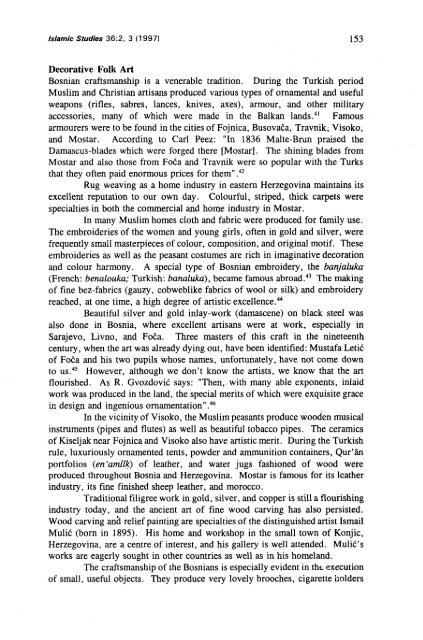Create successful ePaper yourself
Turn your PDF publications into a flip-book with our unique Google optimized e-Paper software.
Islamic Studies 3 6 : 2, 3 ( 1 9 9 7 1 153<br />
Decorative Folk Art<br />
Bosnian craftsmanship is a venerable tradition. During the Turkish period<br />
Muslim and Christian artisans produced various types of ornamental and useful<br />
weapons (rifles, sabres, lances, knives, axes), armour, and other military<br />
accessories, many of which were made in the Balkan land^.^' Famous<br />
armourers were to be found in the cities of Fojnica, Busovafa, Travnik, Visoko,<br />
and Mostar. According to Carl Peez: "In 1836 Malte-Brun praised the<br />
Damascus-blades which were forged there [Mostar]. The shining blades from<br />
Mostar and also those from FoEa and Travnik were so popular with the Turks<br />
that they often paid enormous prices for them" .42<br />
Rug weaving as a home industry in eastern Herzegovina maintains its<br />
excellent reputation to our own day. Colourful, striped, thick carpets were<br />
specialties in both the commercial and home industry in Mostar.<br />
In many Muslim homes cloth and fabric were produced for family use.<br />
The embroideries of the women and young girls, often in gold and silver, were<br />
frequently small masterpieces of colour, composition, and original motif. These<br />
embroideries as well as the peasant costumes are rich in imaginative decoration<br />
and colour harmony. A special type of Bosnian embroidery, the banjaluka<br />
(French: benalouka; Turkish: banaluka), became famous abroad.43 The making<br />
of fine bez-fabrics (gauzy, cobweblike fabrics of wool or silk) and embroidery<br />
reached, at one time, a high degree of artistic excellence."<br />
Beautiful silver and gold inlay-work (damascene) on black steel was<br />
also done in Bosnia, where excellent artisans were at work, especially in<br />
Sarajevo, Livno, and FoEa. Three masters of this craft in the nineteenth<br />
century, when the art was already dying out, have been identified: Mustafa LetiC<br />
of FoEa and his two pupils whose names, unfortunately, have not come down<br />
to However, although we don't know the artists, we know that the art<br />
flourished. As R. GvozdoviC says: "Then, with many able exponents, inlaid<br />
work was produced in the land, the special merits of which were exquisite grace<br />
in design and ingenious ~rnamentation".~~<br />
In the vicinity of Visoko, the Muslim peasants produce wooden musical<br />
instruments (pipes and flutes) as well as beautiful tobacco pipes. The ceramics<br />
of Kiseljak near Fojnica and Visoko also have artistic merit. During the Turkish<br />
rule, luxuriously ornamented tents, powder and ammunition containers, Qur'h<br />
portfolios (en'amlik) of leather, and water jugs fashioned of wood were<br />
produced throughout Bosnia and Herzegovina. Mostar is famous for its leather<br />
industry, its fine finished sheep leather, and morocco.<br />
Traditional filigree work in gold, silver, and copper is still a flourishing<br />
industry today, and the ancient art of fine wood carving has also persisted.<br />
Wood carving and relief painting are specialties of the distinguished artist Ismail<br />
MuliC (born in 1895). His home and workshop in the small town of Konjic,<br />
Herzegovina, are a centre of interest, and his gallery is well attended. MuliC's<br />
works are eagerly sought in other countries as weil as in his homeland.<br />
The craftsmanship of the Bosnians is especially evident in tht execution<br />
of small, useful objects. They produce very lovely brooches, cigarette holders
















